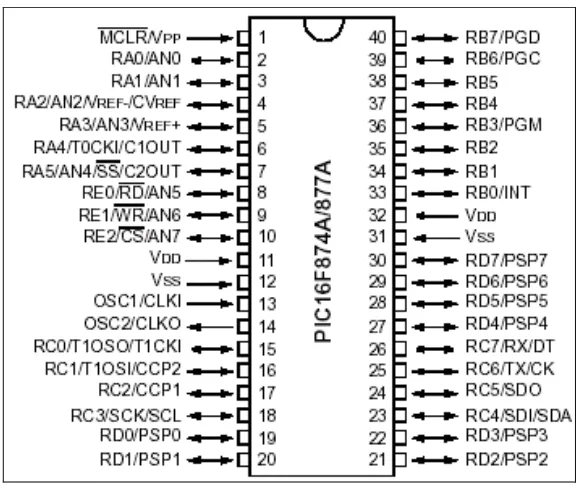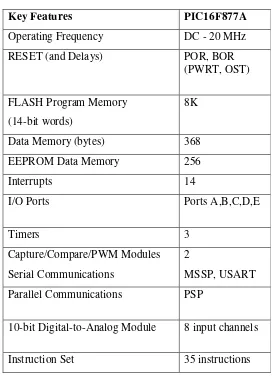FENCE INTRUDER DETECTION SYSTEM (FIDS)
CHUINK BENG CHEONG
This report is submitted in partial fulfillment of the requirements for the award of Bachelor of Electronic Engineering (Computer Engineering) With Honours
Faculty of Electronic and Computer Engineering Universiti Teknikal Malaysia Melaka
UNIVERSTI TEKNIKAL MALAYSIA MELAKA
FAKULTI KEJURUTERAAN ELEKTRONIK DAN KEJURUTERAAN KOMPUTER
BORANG PENGESAHAN STATUS LAPORAN PROJEK SARJANA MUDA II
Tajuk Projek : Fence Intruder Detection System (FIDS)
Sesi
Pengajian : 2 / 2008/2009
Saya ………CHUINK BENG CHEONG……… (HURUF BESAR)
mengaku membenarkan Laporan Projek Sarjana Muda ini disimpan di Perpustakaan dengan syarat-syarat kegunaan seperti berikut:
1. Laporan adalah hakmilik Universiti Teknikal Malaysia Melaka.
2. Perpustakaan dibenarkan membuat salinan untuk tujuan pengajian sahaja.
3. Perpustakaan dibenarkan membuat salinan laporan ini sebagai bahan pertukaran antara
institusi pengajian tinggi.
4. Sila tandakan ( √ ) :
SULIT*
(Mengandungi maklumat yang berdarjah keselamatan atau kepentingan Malaysia seperti yang termaktub di dalam AKTA RAHSIA RASMI 1972)
TERHAD* (Mengandungi maklumat terhad yang telah ditentukan oleh
organisasi/badan di mana penyelidikan dijalankan)
TIDAK TERHAD
Disahkan oleh:
__________________________ ___________________________________
(TANDATANGAN PENULIS) (COP DAN TANDATANGAN PENYELIA)
Alamat Tetap: NO 180, KPG BATU JONG,
18000 KUALA KRAI, KELANTAN.
DECLARATIONS
“I hereby declare that this report is the result of my own work except for quotes as cited in the references.”
“I hereby declare that I have read this report and in my opinion this report is sufficient in terms of the scope and quality for the award of Bachelor of Electronic
Engineering (Computer Engineering) With Honours”.
Signature : ………..
Supervisor’s Name : ………..
ACKNOWLEDGEMENT
First and foremost, I’m very grateful to all those who contributed time, concern and efforts to teach in order to provide and to pass on knowledge. At the same time, I would like to special thanks to my supervisor; En. Imran Bin Ibrahim, because of his comments, critiques, and suggestion were taken seriously to make me understand the world of engineering. Their supports have leaded me to practice and learn more and more from them in order to be an engineer in the future.
I also wish to thank the countless individuals who have shared their suggestion and evaluations in my works all the time. However, the experience that I have gained would not been made possible without the guidance of all engineers, assistant engineers, technicians and operators.
ABSTRACT
ABSTRAK
TABLE OF CONTENTS
CHAPTER CONTENT PAGE
PROJECT TITLE i
DECLARATIONS iii
DEDICATION v
ACKNOWLEDGEMENT vi
ABSTRACT vii
ABSTRAK viii
TABLE OF CONTENTS ix
LIST OF TABLES xii
LIST OF FIGURES xiii
LIST OF ABBREVIATIONS xv
LIST OF APPENDIX xvi
I INTRODUCTION
1.1 BACKGROUND STUDY 1
1.2 OBJECTIVE 2
1.3 PROBLEM STATEMENT 3
1.4 SCOPE 3
1.5 METHODOLOGY 3
1.6 REPORT STRUCTURE 4
II LITERATURE REVIEW
CONTROLLER (PIC) 5 2.2.1 MICROCONTROLLER-PIC 16F877A 7
2.3 RS 232 SERIAL PORT 13
2.3.1 NULL MODEM CABLES 15
2.3.2 VOLTAGE LEVELS 16
2.3.3 DATA FLOW CONTROL 17
2.4 PROTEUS 7 PROFESSIONAL 18
2.5 COMPILER 19
2.5.1 INTRODUCTION TO CCS COMPILER 19
2.6 SENSOR 21
2.6.1 INFRA-RED SENSOR 21
2.6.2 SHOCK SENSOR 22
2.7 CASE STUDY 24
2.7.1 CASE STUDY 1 24
2.7.2 CASE STUDY 2 (Electro-Fence) 25 2.7.2.1 LATEST TECHNOLOGY AND
SAFETY 25
2.7.2.2 KEY FEATURES 25
2.7.2.3 ULTIMATE SECURITY AND
EASY TO OPERATE 26
2.7.2.4 SPECIFICATIONS 26
2.8 WIRELESS CONNECTION 27
2.8.1 ENCODER 27
2.8.2 DECODER 30
2.8.3 RF MODULE 33
2.9 MICROSOFT VISUAL BASIC 2008 EXPRESS
EDITION 34
III PROJECT METHODOLOGY
3.1 INTRODUCTION 36
3.2.1 PROTEUS 7 PROFESSIONAL 40
3.2.2 SENSOR IMPLEMENTATION 42
3.2.3 WIRELESS CONNECTIVITY 43
3.2.3.1 ENCODER & DECODER 43
3.3 SOFTWARE DEVELOPMENT 45
3.3.1 GRAPHICAL USER INTERFACE (GUI)
VIA VISUAL BASIC 2008 46
IV RESULT
4.1 INTRODUCTION 48
4.2 HARDWARE FABRICATION AND
CIRCUIT TESTING 49
4.3 WIRELESS DATA TRANSMISSION 52
4.4 GRAPHICAL USER INTERFACE (GUI)
VIA VISUAL BASIC 54
V CONCLUSION
5.1 INTRODUCTION 57
5.2 CONCLUSION 57
5.3 FUTURE WORKS 58
LIST OF TABLE
NO TITLE PAGE
2.1 Key Features of PIC 16F877A 8
2.2 Operation of each pin 10
2.3 Special Function Register 12
2.4 Pin Out Description (DB9) 13
2.5 connection between 2 pc 15
2.6 Circuit Class & Logic 16
2.7 Specifications 26
2.8 HT12E Pin Description 28
2.9 HT12D Pin Description 31
LIST OF FIGURE
NO TITLE PAGE
2.1 Peripheral Interface Controller (PIC) 5
2.2 PIC 16F877A 7
2.3 Block Diagram of PIC 16F877A 9
2.4 RS232 pin out 13
2.5(a) Connection overview 14
2.5(b) RS232 null modem 14
2.6 Voltage level for RS232 16
2.7 ISIS 7 Professional User Interface 18
2.8 PIC CCS Compiler Interface 20
2.9 Basic Circuit for Infrared Sensor 21
2.10 Encoder and Decoder 27
2.11 HT12E 27
2.12 Timing transmission for the HT12E 28
2.13 Flowchart of HT12E operation 29
2.14 HT12ED 30
2.15 Flowchart of HT12D operation 32
2.16(a) Transmitter module 33
2.16(b) Receiver module 33
3.1 Flow Chart of Hardware Development 37
3.2(a) FIDS block diagram (Transmitter) 38
3.2(b) FIDS block diagram (Receiver) 39
3.3 Schematic of PIC 16F877A 40
3.4 Relay Connection 42
3.7 Visual Basic 2008 Express Edition 46
3.8 List Box 47
3.9 Picture box 47
4.1 Front view of the house model 49
4.2 Top view of the house model 49
4.3 Side view of the house model 50
4.4 Control panel unit 50
4.5(a) Zone 2 intruded 51
4.5(b) Zone 1, 2 & 3 intruded 51
4.5(c) Zone 1, 2 & 4 intruded 51
4.6 Wireless transmission indicators 52
4.7 RF Transmitter 52
4.8 RF Receiver 52
4.9 Graphical User Interface (GUI) 54
4.10 Image Capture 55
LIST OF ABBREVIATIONS
FIDS - Fence Intruder Detection System SFR - Special Function Register PIC - Peripheral Interface Controller
RAM - Random Access Memory
ROM - Read Only Memory
GUI - Graphic User Interface ADC - Analog Digital Converter DAC - Digital Analog Converter
EEPROM - Electrically Erasable Programmable Read-Only Memory
CCP - Capture/Compare/PWM
PWM - Pulse Width Module DTE - Data Terminal Equipment
DCE - Data Circuit-terminating Equipment LED - Light Emitter Diode
UTeM - Universiti Teknikal Malaysia Melaka
RF - Radio Frequency
VT - Valid Transmission
LIST OF APPENDIX
NO TITLE PAGE
A1 PIC16F877A- Coding 60
CHAPTER I
INTRODUCTION
1.1 BACKGROUND STUDY
The main objective of this project is to design a Fence Intruder Detection System (FIDS) that capable to track the existence of burglars efficiently. Most of the system available in market was expensive in term of cost and easily hacked by the intruder. Hence, this project is mainly developed to reduce the number of burglary cases in the housing area. The fence intruder detection system designed also must be low cost and high efficiency.
Another objective of this project is to reveal the capability of the PIC16F877A microcontroller. Microcontroller is an integrated chip that combined all the system in microcomputer. Generally, PIC used to store the instructions the operating system. In this project, PIC microcontroller used to convert the analog input received from the sensors into digital signal before transmits the data to control panel.
Besides, designer also will be exposed to the various functions of Visual Basic. Visual Basic used to create a Graphical User Interface (GUI) that act as control panel to the FIDS system. The system able to capture and store data by using suitable program that linked to Visual Basic. Hence, Visual Basic functioned to monitor the operating system through the central unit processing.
Before construct the hardware part, designer must test the designed circuit whether function properly or otherwise. Proteus Schematic Simulation and CCS Compiler is the suitable program to build and test the system. Proteus used to build the circuit while CCS Compiler is compiler for the microcontroller. Simulation is important so that any modification or improvement can be done to the designed system. Besides, the cost of construction also can be minimize by reduce the number failure in circuitry construction.
1.3 PROBLEM STATEMENT
A false alarm can be defined as an alarm condition that resulted from something other than a break-in, fire or an actual emergency situation. When a sensor operates, it is hardly false, and it is usually a true indication of the present state of the sensor. A more appropriate term is nuisance, indicating that the alarm activation is inconvenient, annoying, or vexatious. A sensor unable to differentiates between the motion of human and animal. Hence, the alarm system frequently creates the nuisance alarm that becomes a problem to residents. Over time, repeated false alarms in a certain area may cause occupants to start to ignore all alarms, knowing that each time it will likely be a fake.
1.4 SCOPE OF WORK
This project is subjected to several scope and limitations that are narrowed down to the study. One of the main subjects is to develop an interface between hardware and software of the microcontroller. Besides, this project also subjected to construct the model of security system that focus on the house perimeter.
1.5 METHODOLOGY
Chapter one briefly introduces the overall of the project titled Fence Intruder Detection System (FIDS). The introduction consists of overview, objective, problem statement, scope of work, methodology and structure report.
Meanwhile, chapter two discuss about the background of study related to FIDS system. Literature review will produce overall structure of the FIDS system which shows the relation between project research and theoretical concept.
Chapter three will explain about the project methodology. Project methodology give details about the method used to solve problem to complete the project. The methods used such as collecting data method, process and analysis data method, modeling and etc.
Chapter four consists of result and discussion to all an initial result, finding and analyses during the research.
CHAPTER II
LITERATURE REVIEW
2.1 INTRODUCTION
This chapter is a literature review on theoretical concepts applied in this project. This chapter includes with the brief explanation on the operation of Fence Intruder Detection System (FIDS), what are microcontroller, RS232 and sensor.
2.2 PERIPHERAL INTERFACE CONTROLLER (PIC)
PIC is a family of Harvard architecture microcontrollers made by Microchip Technology, derived from the PIC1640 originally developed by General Instrument's Microelectronics Division. The name PIC initially referred to "Programmable Interface Controller".
extensive collection of application notes, availability of low cost or free development tools, and serial programming (and re-programming with flash memory) capability.
The PIC architecture can be generally characterized by the following features:
a) separate code and data spaces (Harvard architecture)
b) a small number of fixed length instructions
c) most instructions are single cycle execution (4 clock cycles), with single delay cycles upon branches and skips
d) a single accumulator (W), the use of which (as source operand) is implied (ie is not encoded in the opcode)
e) All RAM locations function as registers as both source and/or destination of math and other functions.
f) a hardware stack for storing return addresses
g) a fairly small amount of addressable data space (typically 256 bytes), extended through banking
h) data space mapped CPU, port, and peripheral registers
i) the program counter is also mapped into the data space and writable (this is used to implement indirect jumps)
2.2.1 MICROCONTROLLER- PIC 16F877A
[image:23.612.181.472.238.482.2]Generally, there are many types of PIC had been produced based on specification for each of them. Besides, the construction of the latest PICs also improved by referring to the previous construction. For this project, designer had chosen the PIC 16F877A based on the suitability to this project. Below is the data sheet of the PIC 16F877A that consist of 40 pins.[2] [3]
Figure 2.2 Figure of PIC16F877A
Key Features PIC16F877A
Operating Frequency DC - 20 MHz
RESET (and Delays) POR, BOR
(PWRT, OST)
FLASH Program Memory (14-bit words)
8K
Data Memory (bytes) 368
EEPROM Data Memory 256
Interrupts 14
I/O Ports Ports A,B,C,D,E
Timers 3
Capture/Compare/PWM Modules 2
Serial Communications MSSP, USART
Parallel Communications PSP
10-bit Digital-to-Analog Module 8 input channels
[image:24.612.189.463.96.472.2]
